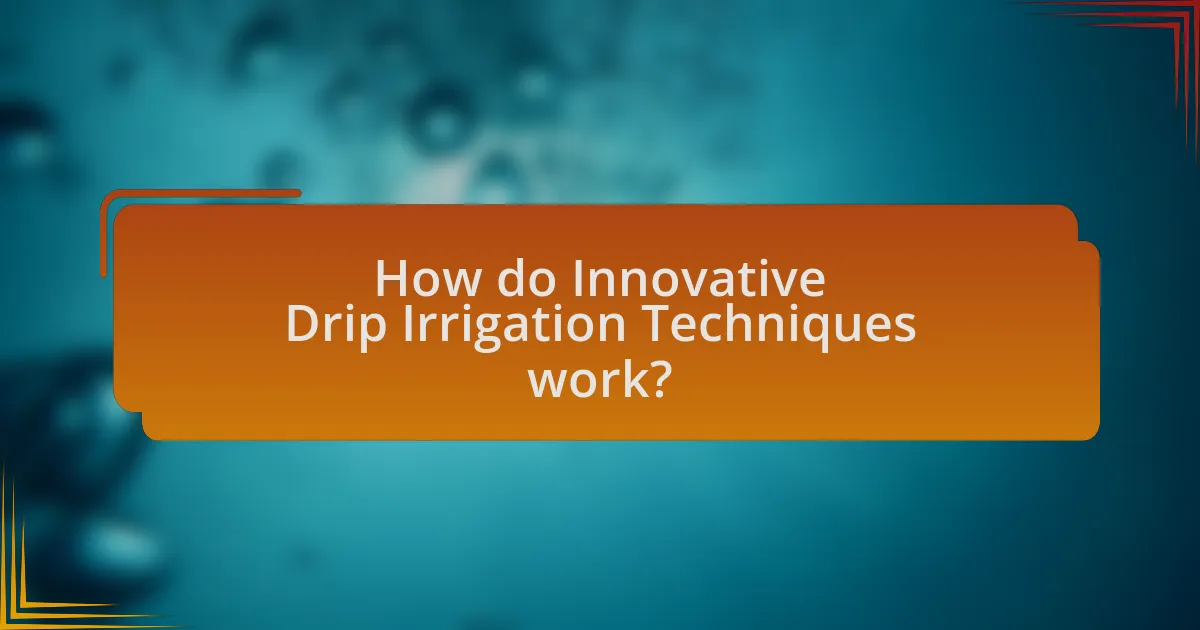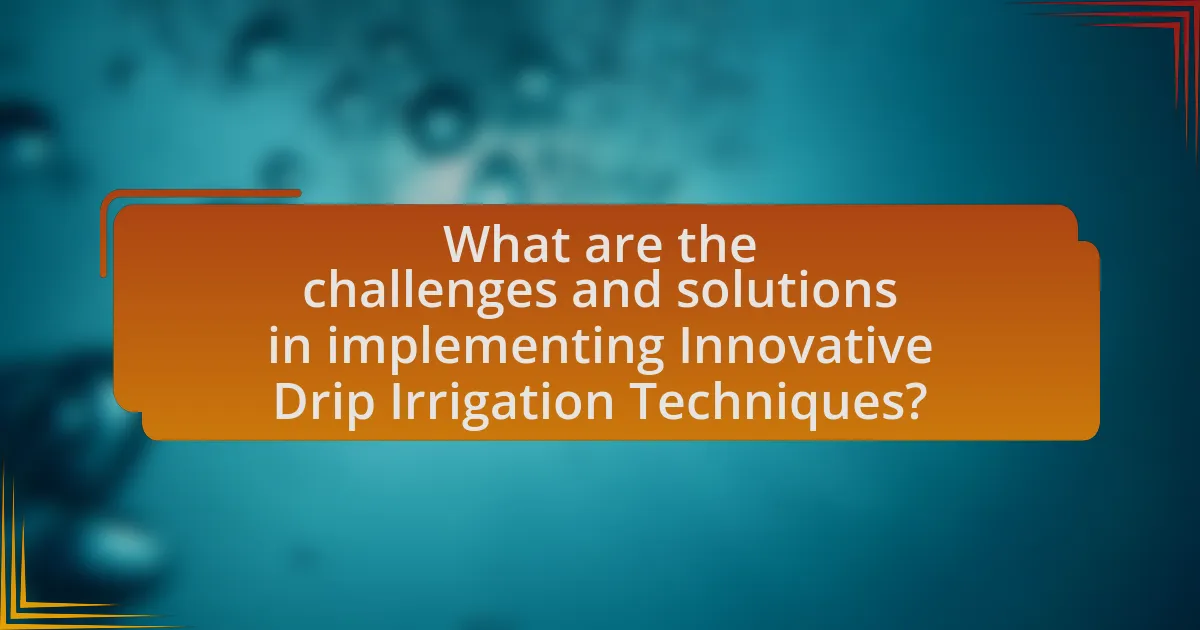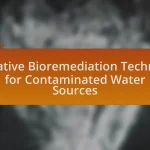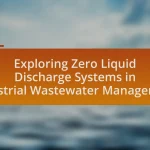Innovative drip irrigation techniques are essential for water conservation in agriculture, utilizing advanced methods such as soil moisture sensors, pressure-compensating emitters, and subsurface systems to optimize water usage. These techniques significantly reduce water consumption—by up to 50% compared to traditional irrigation—while enhancing crop yields and promoting sustainable agricultural practices. The article explores the differences between innovative and conventional irrigation methods, the environmental benefits of drip irrigation, and the challenges farmers face in adopting these systems. Additionally, it discusses the importance of proper system design, maintenance practices, and available resources for farmers to effectively implement water-saving technologies.
What are Innovative Drip Irrigation Techniques for Water Conservation?

Innovative drip irrigation techniques for water conservation include the use of soil moisture sensors, pressure-compensating emitters, and subsurface drip irrigation systems. Soil moisture sensors optimize water application by measuring moisture levels and adjusting irrigation schedules accordingly, which can reduce water usage by up to 30%. Pressure-compensating emitters ensure uniform water distribution even on uneven terrain, enhancing efficiency. Subsurface drip irrigation involves placing the drip lines below the soil surface, minimizing evaporation and runoff, and can lead to water savings of 20-50% compared to traditional methods. These techniques collectively contribute to more sustainable agricultural practices and effective water management.
How do these techniques differ from traditional irrigation methods?
Innovative drip irrigation techniques differ from traditional irrigation methods primarily in their efficiency and precision of water application. Traditional methods often involve surface irrigation, which can lead to significant water loss through evaporation and runoff, while drip irrigation delivers water directly to the plant roots, minimizing waste. Studies indicate that drip irrigation can reduce water usage by up to 50% compared to conventional methods, making it a more sustainable option for agriculture.
What are the key features of innovative drip irrigation systems?
Innovative drip irrigation systems feature precision water delivery, which minimizes water waste by directing moisture directly to the plant roots. These systems often incorporate smart technology, such as soil moisture sensors and automated timers, to optimize irrigation schedules based on real-time data. Additionally, they utilize advanced materials for durability and efficiency, including pressure-compensating emitters that ensure uniform water distribution across varying terrain. Research indicates that these systems can reduce water usage by up to 50% compared to traditional irrigation methods, significantly enhancing water conservation efforts in agriculture.
Why is water conservation critical in agriculture?
Water conservation is critical in agriculture because it ensures sustainable crop production while minimizing water scarcity. Agriculture accounts for approximately 70% of global freshwater use, making efficient water management essential to meet the growing food demand without depleting water resources. Implementing water conservation techniques, such as innovative drip irrigation, can reduce water usage by up to 60% compared to traditional methods, thereby enhancing water efficiency and crop yield. This is particularly important in regions facing drought or limited water supply, where conserving water can significantly impact food security and agricultural sustainability.
What are the environmental benefits of using innovative drip irrigation?
Innovative drip irrigation significantly reduces water usage, leading to enhanced water conservation. This method delivers water directly to the plant roots, minimizing evaporation and runoff, which can account for up to 50% of water loss in traditional irrigation systems. Additionally, it promotes healthier plant growth by providing consistent moisture levels, which can reduce the need for chemical fertilizers and pesticides, thereby decreasing soil and water pollution. Studies indicate that drip irrigation can improve water use efficiency by 30-50%, making it a sustainable choice for agriculture that supports environmental health.
How does drip irrigation reduce water wastage?
Drip irrigation reduces water wastage by delivering water directly to the plant roots in a controlled manner, minimizing evaporation and runoff. This method allows for precise application of water, ensuring that only the necessary amount reaches the plants, which can lead to water savings of up to 30-50% compared to traditional irrigation methods. Studies have shown that drip irrigation can significantly enhance water use efficiency, making it a crucial technique for sustainable agriculture and water conservation.
What impact does it have on soil health and crop yield?
Innovative drip irrigation techniques significantly enhance soil health and crop yield. These methods improve water efficiency, reducing soil erosion and nutrient leaching, which are critical for maintaining soil structure and fertility. Research indicates that drip irrigation can increase crop yields by 20-90% compared to traditional irrigation methods, as it delivers water directly to the root zone, optimizing moisture availability and minimizing water stress. Additionally, studies show that improved soil moisture retention leads to better microbial activity and organic matter content, further promoting soil health.
How do Innovative Drip Irrigation Techniques work?

Innovative drip irrigation techniques work by delivering water directly to the root zone of plants through a network of tubing and emitters. This method minimizes evaporation and runoff, ensuring that water is used efficiently. For instance, systems can be equipped with sensors that monitor soil moisture levels, allowing for precise irrigation scheduling based on actual plant needs. Research indicates that these techniques can reduce water usage by up to 50% compared to traditional irrigation methods, significantly enhancing water conservation efforts in agriculture.
What components are essential for an effective drip irrigation system?
An effective drip irrigation system requires several essential components: a water source, filtration system, pressure regulator, mainline tubing, emitters, and connectors. The water source provides the necessary supply, while the filtration system removes debris to prevent clogging. A pressure regulator ensures consistent water pressure, which is crucial for uniform distribution. Mainline tubing transports water from the source to the emitters, which deliver water directly to the plant roots. Connectors are used to join various components, ensuring a complete and functional system. Each of these components plays a critical role in maximizing water efficiency and promoting healthy plant growth.
How do emitters function in a drip irrigation setup?
Emitters in a drip irrigation setup function by delivering a controlled amount of water directly to the root zone of plants. These devices regulate water flow through small openings, allowing for precise irrigation that minimizes water waste. Emitters can be pressure-compensating or non-pressure-compensating, ensuring consistent water delivery regardless of changes in pressure within the system. This targeted approach not only conserves water but also promotes healthier plant growth by providing moisture directly where it is needed, reducing evaporation and runoff.
What role does pressure regulation play in these systems?
Pressure regulation is crucial in innovative drip irrigation systems as it ensures consistent water delivery to plants, optimizing water use efficiency. By maintaining a specific pressure range, these systems prevent over-irrigation and under-irrigation, which can lead to water wastage and crop stress. Studies have shown that proper pressure regulation can improve water distribution uniformity, resulting in better crop yields and reduced water consumption. For instance, research indicates that maintaining optimal pressure levels can enhance the performance of drip emitters, leading to a 20-30% reduction in water usage compared to traditional irrigation methods.
What technologies are integrated into modern drip irrigation systems?
Modern drip irrigation systems integrate several advanced technologies, including automated controllers, sensors, and pressure regulators. Automated controllers enable precise scheduling and management of water delivery based on real-time data, optimizing water usage. Sensors, such as soil moisture sensors and weather stations, provide critical information that helps in adjusting irrigation practices to current environmental conditions. Pressure regulators ensure consistent water flow and prevent system damage, enhancing efficiency. These technologies collectively contribute to improved water conservation and crop yield, making modern drip irrigation systems highly effective in agricultural practices.
How does automation enhance the efficiency of drip irrigation?
Automation enhances the efficiency of drip irrigation by enabling precise control over water delivery, ensuring that plants receive the optimal amount of water at the right times. Automated systems utilize sensors and timers to monitor soil moisture levels and environmental conditions, allowing for real-time adjustments to irrigation schedules. This targeted approach reduces water waste and minimizes the risk of over- or under-watering, which can lead to improved crop yields and healthier plants. Studies have shown that automated drip irrigation systems can reduce water usage by up to 30% compared to traditional methods, demonstrating significant improvements in water conservation and agricultural productivity.
What is the significance of soil moisture sensors in these systems?
Soil moisture sensors are crucial in innovative drip irrigation systems for water conservation as they provide real-time data on soil moisture levels. This data enables precise irrigation scheduling, ensuring that water is applied only when necessary, which reduces water waste and promotes efficient water use. Studies have shown that using soil moisture sensors can lead to water savings of up to 30% compared to traditional irrigation methods, thereby enhancing crop yield and sustainability.
What are the challenges and solutions in implementing Innovative Drip Irrigation Techniques?

The challenges in implementing innovative drip irrigation techniques include high initial costs, technical complexity, and the need for skilled labor. High initial costs can deter farmers from adopting these systems, as they require significant investment in equipment and installation. Technical complexity arises from the need for proper design and maintenance, which can be challenging for those unfamiliar with advanced irrigation systems. Additionally, the requirement for skilled labor to manage and operate these systems can limit adoption in regions with a shortage of trained personnel.
Solutions to these challenges involve financial assistance programs, training initiatives, and the development of user-friendly technologies. Financial assistance, such as subsidies or low-interest loans, can help offset the initial costs for farmers. Training programs can educate farmers on the benefits and operation of drip irrigation systems, making them more accessible. Furthermore, advancements in technology, such as automated systems and mobile applications for monitoring, can simplify the management of drip irrigation, making it easier for farmers to adopt and maintain these systems.
What common obstacles do farmers face when adopting these techniques?
Farmers commonly face financial constraints, lack of technical knowledge, and inadequate infrastructure when adopting innovative drip irrigation techniques for water conservation. Financial constraints often arise from the high initial investment required for purchasing and installing drip systems, which can deter farmers, especially those with limited resources. Additionally, a lack of technical knowledge can hinder effective implementation and maintenance of these systems, as farmers may not be familiar with the technology or best practices. Inadequate infrastructure, such as poor access to reliable water sources or insufficient support services, further complicates the adoption process, making it challenging for farmers to fully benefit from these water-saving techniques.
How can initial costs be justified through long-term savings?
Initial costs of innovative drip irrigation techniques can be justified through long-term savings by significantly reducing water usage and improving crop yields. For instance, studies show that drip irrigation can reduce water consumption by up to 50% compared to traditional irrigation methods, leading to lower water bills and conservation of resources. Additionally, enhanced efficiency in water delivery can result in increased agricultural productivity, with some reports indicating yield increases of 20-30%. Over time, these savings in water costs and increased revenue from higher yields can offset the initial investment, making the long-term financial benefits clear.
What maintenance practices are necessary for optimal performance?
Regular maintenance practices necessary for optimal performance of drip irrigation systems include inspecting and cleaning emitters, checking for leaks, and monitoring system pressure. Cleaning emitters prevents clogging, which can reduce water flow and efficiency; studies show that clogged emitters can decrease water application rates by up to 50%. Checking for leaks ensures that water is delivered efficiently to plants, as leaks can lead to significant water loss. Monitoring system pressure is crucial because it affects the uniformity of water distribution; maintaining the recommended pressure range can enhance system performance and crop yield.
What are the best practices for maximizing the effectiveness of drip irrigation?
The best practices for maximizing the effectiveness of drip irrigation include proper system design, regular maintenance, and appropriate scheduling of irrigation. Proper system design ensures that the layout of the drip lines matches the crop requirements and soil characteristics, which can enhance water distribution efficiency. Regular maintenance, such as checking for clogs and leaks, is crucial as it prevents water loss and ensures optimal performance. Additionally, scheduling irrigation based on soil moisture levels and crop needs can significantly reduce water waste, as studies show that precise timing can improve water use efficiency by up to 30%. Implementing these practices leads to better water conservation and improved crop yields.
How can farmers tailor drip irrigation systems to specific crops?
Farmers can tailor drip irrigation systems to specific crops by adjusting the emitter flow rates, spacing, and irrigation schedules based on the water requirements of each crop. For instance, crops like tomatoes may require higher water application rates compared to drought-resistant crops like peppers. Additionally, farmers can implement soil moisture sensors to monitor the moisture levels and adjust the irrigation frequency accordingly, ensuring that each crop receives optimal water without over-irrigation. Research indicates that customized drip irrigation can improve water use efficiency by up to 30%, demonstrating its effectiveness in meeting the specific needs of different crops.
What strategies can be employed to monitor and adjust water usage?
To monitor and adjust water usage effectively, implementing smart irrigation systems is essential. These systems utilize sensors to measure soil moisture levels, weather conditions, and plant water needs, allowing for precise irrigation scheduling. Research indicates that smart irrigation can reduce water usage by up to 30% compared to traditional methods, as it ensures water is applied only when necessary. Additionally, using flow meters can help track water consumption in real-time, enabling adjustments based on actual usage patterns. This data-driven approach not only conserves water but also enhances crop yield and health.
What resources are available for farmers interested in innovative drip irrigation?
Farmers interested in innovative drip irrigation can access various resources, including government programs, agricultural extension services, and online platforms. Government programs often provide financial assistance and technical support for implementing advanced irrigation systems, such as the USDA’s Environmental Quality Incentives Program, which offers cost-sharing for conservation practices. Agricultural extension services offer workshops, training sessions, and expert consultations to educate farmers on the latest drip irrigation technologies and best practices. Additionally, online platforms like the Irrigation Association and various agricultural universities provide research articles, case studies, and instructional videos that detail innovative techniques and technologies in drip irrigation, helping farmers make informed decisions.
Where can farmers find training and support for implementing these systems?
Farmers can find training and support for implementing innovative drip irrigation systems through agricultural extension services, local universities, and specialized organizations focused on sustainable agriculture. Agricultural extension services often provide workshops and resources tailored to local farming practices, while universities may offer research-based training programs. Organizations such as the Irrigation Association and the World Bank also provide resources, guidelines, and training sessions specifically aimed at improving water conservation techniques in agriculture.
What funding opportunities exist for adopting water conservation technologies?
Funding opportunities for adopting water conservation technologies include government grants, private sector investments, and nonprofit organization support. For instance, the U.S. Department of Agriculture offers the Environmental Quality Incentives Program, which provides financial assistance to farmers implementing water-saving practices. Additionally, various state-level programs and initiatives, such as California’s Save Our Water program, offer funding specifically for water conservation technologies. Nonprofit organizations like the Nature Conservancy also provide grants for innovative water management solutions. These funding sources are designed to encourage the adoption of technologies that enhance water efficiency and sustainability.
What practical tips can enhance the success of drip irrigation systems?
To enhance the success of drip irrigation systems, it is essential to ensure proper system design and maintenance. Proper design includes selecting the right emitter spacing and flow rate based on crop needs, which can significantly improve water efficiency. Regular maintenance, such as checking for clogs and leaks, is crucial; studies show that even a small leak can waste up to 20% of water in irrigation systems. Additionally, incorporating soil moisture sensors can optimize watering schedules, ensuring that plants receive adequate moisture without over-irrigation, thereby conserving water.


